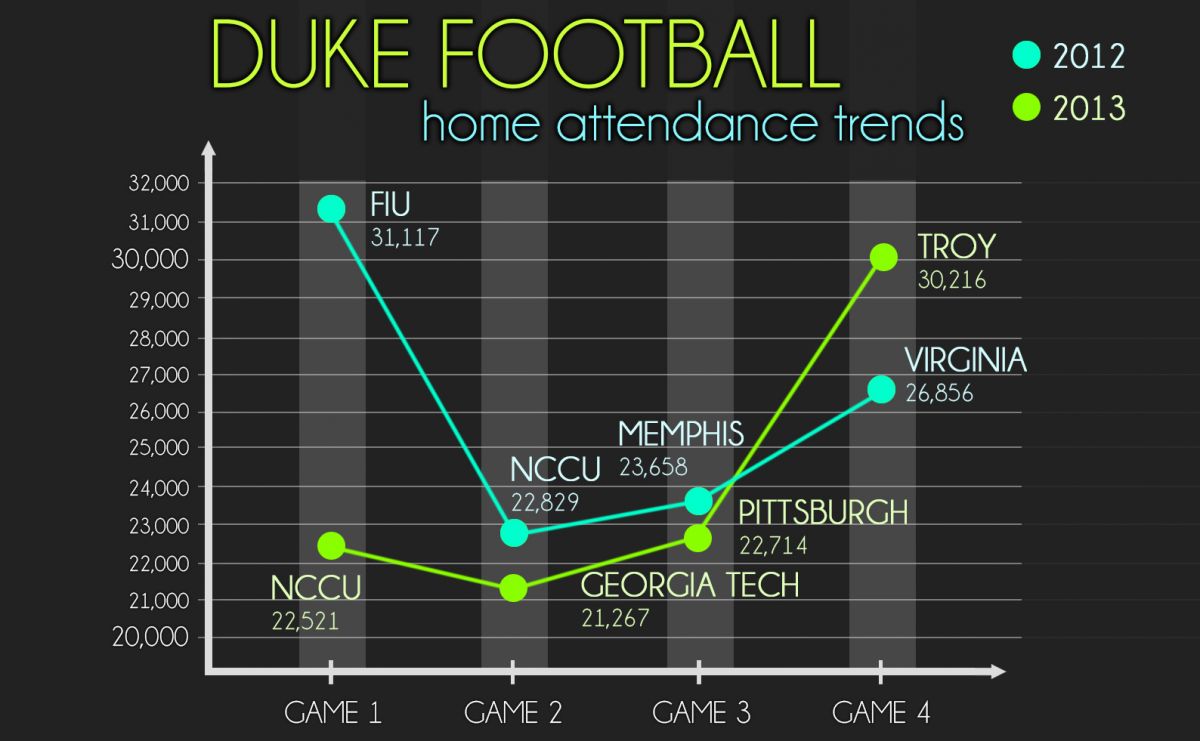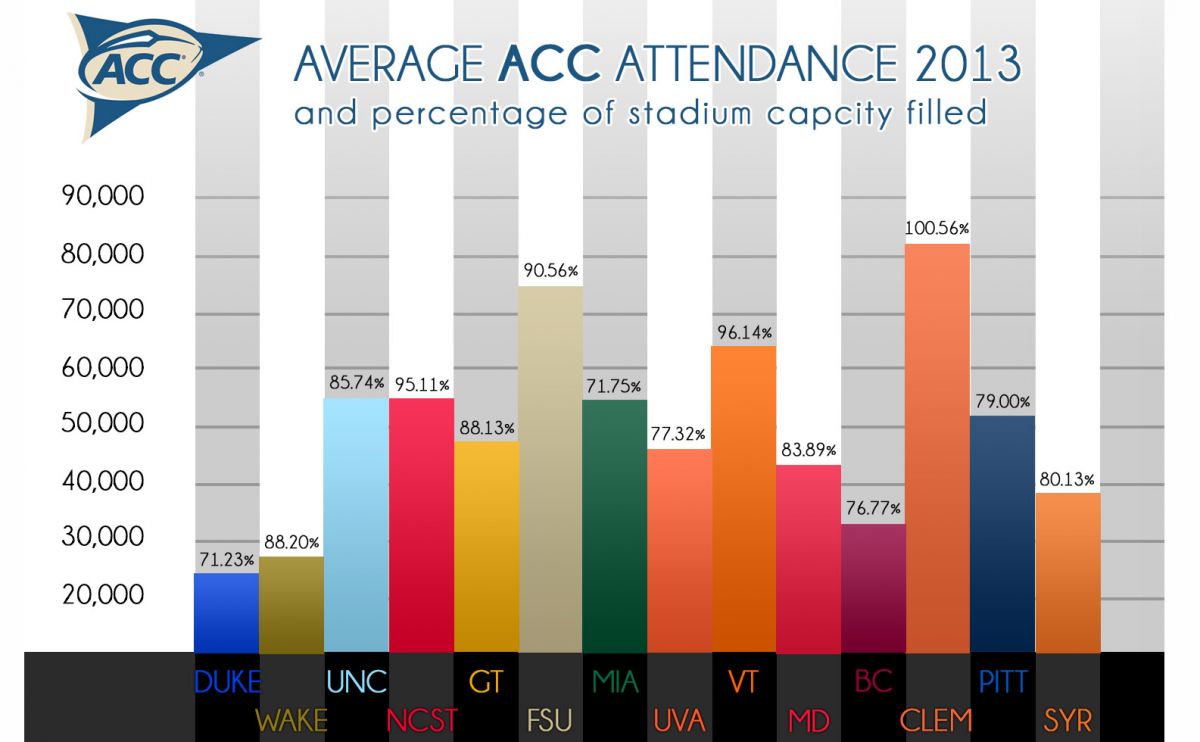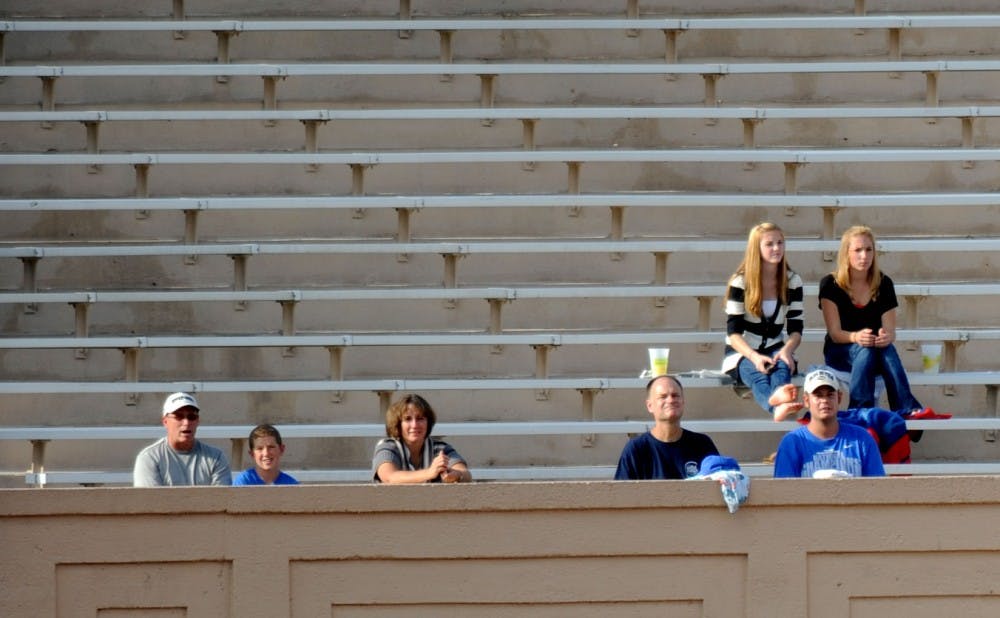Among the most ambitious goals laid out in the initial plans for athletic facility renovations in Duke Forward was the completion of the Wallace Wade Stadium’s bowl, increasing seating capacity to “nearly 44,000.”
The reaction of anybody who has been a part of the sparse crowds at Duke games this season or seen them on TV: Huh?
But as the athletic department laid out to the Board of Trustees this weekend in a standard quarterly update, the ultimate goal isn’t expanding seating capacity—it’s about improving the fan experience.
“We’re not as dumb as we might look,” said senior associate athletic director Mike Cragg, who is overseeing the Duke Forward’s sports facility renovations. “The complete bowl shape, that has gone by the wayside.”
Instead, Cragg said realistic options for the future may include expanding the concourse with a natural grass slope so that it goes all the way around, a “Wake Forest or Virginia model” that would provide more seating-type options on the hillside for a family-friendly feel.
So even if completing the bowl may seem like the biggest task from an outside perspective, on the inside they’re preparing different renovations so that five years from now, Wallace Wade looks born again from a fan-experience perspective.
“It will be a brand new stadium,” Cragg said. “I’m very confident that if you and I could jump ahead four-and-a-half years from right now, that I think we’d say, ‘Holy smokes this was not the same place we were at five years ago.’”
For Cragg, it’s all a question of supply and demand. Now, there’s no question that supply exceeds demand, and the first phases of the renovations plan to address that, rather than increasing supply.
Primary to the first phases of change will be overhauling the East Gate and overall concourse. After the 2014 season, the press box currently housed in the Finch-Yeager building will come down while a new tower is constructed that will also house suites and premium amenities. Cragg said adding premium products, which include seating and food, is something they lack now and must address.
“I think it’s proven around the country in different forms that when you build a better venue, that becomes a part of the attraction, and that’s part of the goal, making Wallace Wade part of the attraction,” Cragg said. “It’s not that now, obviously.”
Relocating the Presidents’ box to the new tower while adding those high-end facilities has the greatest potential to change Duke football’s business model, Cragg said.
Importantly, Cragg was also quick to note that even though premium features are a primary goal, so is effectively engaging Duke’s approximately 15,000 students, many of whom do not regularly attend football games.
Part of Cragg's effort to attract more students is removing the track around the field, which will bring fans closer to the action.
That, along with the overhaul to the concourse around the field, may create a small increase in seating capacity though it won’t be a “giant difference in numbers.” That difference in numbers, though, isn’t the goal. The vision is emulating the intimacy that makes Cameron Indoor Stadium one of the most revered venues in all of sports.
Bringing fans closer to the field is just one of those efforts, even though it may be the most critical one. A new and improved scoreboard, placed properly, could have a huge effect. They are also considering changes to Wallace Wade’s metal bleachers. In 2009, the upstairs seats at Cameron were painted blue, a potential change that may be replicated as soon as next season, if it happens. They are also studying other aspects of the seating, which if modified could provide a low-cost and high-impact change to the atmosphere and fan experience, Cragg said.
And as they go through the process of hiring architects, meeting with the Bostock Group again in November and putting these plans in to action, it’s important to remember these plans are subject to change.
Once those changes are completed five years from now and we’re saying ‘holy smokes,’ then we can start talking about those bigger changes for increasing seating capacity, if that’s needed. Growing a stadium by adding end-zone seats isn’t the solution, and they know that. Those are the cheapest seats in the stadium with the worst view. But what if 20 years from now there’s a demand for more seats, so they add a second level of seats at midfield near the East Gate? Now that would be neat.
The decision makers know change is needed, and they’re not trying to fit a square peg in a round hole. Wallace Wade may feel like it’s under constant construction starting after next season, but games will not be affected and the right problems have been identified.
“We certainly recognize the same things you see on Saturdays,” Cragg said.
Get The Chronicle straight to your inbox
Signup for our weekly newsletter. Cancel at any time.

